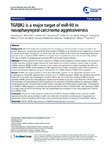TGFβR2 is a major target of miR-93 in nasopharyngeal carcinoma aggressiveness.
| dc.contributor.author | Lyu, X | en |
| dc.contributor.author | Fang, W | en |
| dc.contributor.author | Cai, L | en |
| dc.contributor.author | Zheng, H | en |
| dc.contributor.author | Ye, Y | en |
| dc.contributor.author | Zhang, L | en |
| dc.contributor.author | Li, J | en |
| dc.contributor.author | Peng, H | en |
| dc.contributor.author | Cho, WCS | en |
| dc.contributor.author | Wang, E | en |
| dc.contributor.author | Marincola, FM | en |
| dc.contributor.author | Yao, K | en |
| dc.contributor.author | Cai, H | en |
| dc.contributor.author | Li, J | en |
| dc.contributor.author | Li, X | en |
| dc.date.accessioned | 2017-11-27T15:10:11Z | |
| dc.date.available | 2017-11-27T15:10:11Z | |
| dc.date.issued | 2014-03-08 | en |
| dc.identifier.uri | http://hdl.handle.net/10026.1/10285 | |
| dc.description.abstract |
BACKGROUND: MiR-17-92 cluster and its paralogues have emerged as crucial regulators of many oncogenes and tumor suppressors. Transforming growth factor-β receptor II (TGFβR2), as an important tumor suppressor, is involved in various cancer types. However, it is in cancer that only two miRNAs of this cluster and its paralogues have been reported so far to regulate TGFβR2. MiR-93 is oncogenic, but its targetome in cancer has not been fully defined. The role of miR-93 in nasopharyngeal carcinoma (NPC) still remains largely unknown. METHODS: We firstly evaluated the clinical signature of TGFβR2 down-regulation in clinical samples, and next used a miRNA expression profiling analysis followed by multi-validations, including Luciferase reporter assay, to identify miRNAs targeting TGFβR2 in NPC. In vitro and in vivo studies were performed to further investigate the effects of miRNA-mediated TGFβR2 down-regulation on NPC aggressiveness. Finally, mechanism studies were conducted to explore the associated pathway and genes influenced by this miRNA-mediated TGFβR2 down-regulation. RESULTS: TGFβR2 was down-regulated in more than 50% of NPC patients. It is an unfavorable prognosis factor contributing to clinical NPC aggressiveness. A cluster set of 4 TGFβR2-associated miRNAs was identified; they are all from miR-17-92 cluster and its paralogues, of which miR-93 was one of the most significant miRNAs, directly targeting TGFβR2, promoting cell proliferation, invasion and metastasis in vitro and in vivo. Moreover, miR-93 resulted in the attenuation of Smad-dependent TGF-β signaling and the activation of PI3K/Akt pathway by suppressing TGFβR2, further promoting NPC cell uncontrolled growth, invasion, metastasis and EMT-like process. Impressively, the knockdown of TGFβR2 by siRNA displayed a consentaneous phenocopy with the effect of miR-93 in NPC cells, supporting TGFβR2 is a major target of miR-93. Our findings were also substantiated by investigation of the clinical signatures of miR-93 and TGFβR2 in NPC. CONCLUSION: The present study reports an involvement of miR-93-mediated TGFβR2 down-regulation in NPC aggressiveness, thus giving extended insights into molecular mechanisms underlying cancer aggressiveness. Approaches aimed at blocking miR-93 may serve as a promising therapeutic strategy for treating NPC patients. | en |
| dc.format.extent | 51 - ? | en |
| dc.language | eng | en |
| dc.language.iso | eng | en |
| dc.subject | Adult | en |
| dc.subject | Aged | en |
| dc.subject | Carcinoma | en |
| dc.subject | Cell Movement | en |
| dc.subject | Cell Proliferation | en |
| dc.subject | Female | en |
| dc.subject | Gene Expression Regulation, Neoplastic | en |
| dc.subject | Humans | en |
| dc.subject | Kaplan-Meier Estimate | en |
| dc.subject | Male | en |
| dc.subject | MicroRNAs | en |
| dc.subject | Middle Aged | en |
| dc.subject | Nasopharyngeal Carcinoma | en |
| dc.subject | Nasopharyngeal Neoplasms | en |
| dc.subject | Neoplasm Invasiveness | en |
| dc.subject | Neoplasm Metastasis | en |
| dc.subject | Prognosis | en |
| dc.subject | Protein Serine-Threonine Kinases | en |
| dc.subject | RNA, Small Interfering | en |
| dc.subject | Receptor, Transforming Growth Factor-beta Type II | en |
| dc.subject | Receptors, Transforming Growth Factor beta | en |
| dc.subject | Xenograft Model Antitumor Assays | en |
| dc.title | TGFβR2 is a major target of miR-93 in nasopharyngeal carcinoma aggressiveness. | en |
| dc.type | Journal Article | |
| plymouth.author-url | https://www.ncbi.nlm.nih.gov/pubmed/24606633 | en |
| plymouth.volume | 13 | en |
| plymouth.publication-status | Published online | en |
| plymouth.journal | Mol Cancer | en |
| dc.identifier.doi | 10.1186/1476-4598-13-51 | en |
| plymouth.organisational-group | /Plymouth | |
| plymouth.organisational-group | /Plymouth/REF 2021 Researchers by UoA | |
| plymouth.organisational-group | /Plymouth/REF 2021 Researchers by UoA/UoA01 Clinical Medicine | |
| plymouth.organisational-group | /Plymouth/REF 2021 Researchers by UoA/UoA01 Clinical Medicine/UoA01 Clinical Medicine | |
| dc.publisher.place | England | en |
| dcterms.dateAccepted | 2014-03-01 | en |
| dc.identifier.eissn | 1476-4598 | en |
| dc.rights.embargoperiod | Not known | en |
| rioxxterms.versionofrecord | 10.1186/1476-4598-13-51 | en |
| rioxxterms.licenseref.uri | http://www.rioxx.net/licenses/all-rights-reserved | en |
| rioxxterms.licenseref.startdate | 2014-03-08 | en |
| rioxxterms.type | Journal Article/Review | en |


